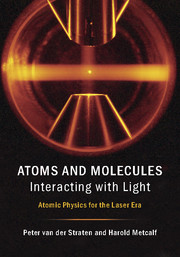Book contents
- Frontmatter
- Contents
- Preface
- Part I Atom–light interaction
- Part II Internal structure
- 7 The hydrogen atom
- 8 Fine structure
- 9 Effects of the nucleus
- 10 The alkali-metal atoms
- 11 Atoms in magnetic fields
- 12 Atoms in electric fields
- 13 Rydberg atoms
- 14 The helium atom
- 15 The periodic system of the elements
- 16 Molecules
- 17 Binding in the hydrogen molecule
- 18 Ultra-cold chemistry
- Part III Applications
- Part IV Appendix
- References
- Index
18 - Ultra-cold chemistry
from Part II - Internal structure
Published online by Cambridge University Press: 05 February 2016
- Frontmatter
- Contents
- Preface
- Part I Atom–light interaction
- Part II Internal structure
- 7 The hydrogen atom
- 8 Fine structure
- 9 Effects of the nucleus
- 10 The alkali-metal atoms
- 11 Atoms in magnetic fields
- 12 Atoms in electric fields
- 13 Rydberg atoms
- 14 The helium atom
- 15 The periodic system of the elements
- 16 Molecules
- 17 Binding in the hydrogen molecule
- 18 Ultra-cold chemistry
- Part III Applications
- Part IV Appendix
- References
- Index
Summary
Introduction
Interactions between separated atoms are complicated by the large number of degrees of freedom of a many-atom system, and are very difficult to describe quantitatively. Although the Hamiltonian for such systems can be written down easily, finding the eigenfunctions requires a sophisticated effort and large computer resources. This area of quantum chemistry, with all its intricacies, is a complex subfield of science that cannot be adequately described in a single book chapter. Therefore the student is referred to specialized books in this field for further reading [165, 170].
In the 1990s a new field of chemistry emerged that considered such interactions between atoms at ultra-cold temperatures. The field focuses strongly on atomic interactions at large internuclear distances where the atoms are well separated and their electronic clouds do not strongly overlap. In such circumstances the interactions are dominated by the properties of the states of the atoms and they can be understood from an atomic point of view. In this chapter the basic features of this field will be described.
The interaction energy (electronic potential energy) between two colliding partners separated by a large distance is called the dissociation limit. Light interactions with the particles can occur with the total energy above or below this limit. The relative kinetic energy does not contribute because it is so very small at such low temperatures. In the presence of a light field tuned below this limit for a pair that has one of the atoms in an excited state, two unbound atoms can be associated into a bound molecular state (for example, an S–P collision of two alkali atoms).
Such photo-association is more likely at a large interatomic separation because there is good radial overlap between the incoming, low-energy scattering state and the outer turning point of the bound excited state, so it usually produces a molecule in a high vibrational state. Studying these states provides important information about interatomic interactions near the dissociation limit. The long-range part of the potential is dominated by atomic parameters and in Sec. 18.2 it is shown how these potentials can be constructed. The LeRoy–Bernstein method, which was developed long before the advent of cold-atom photo-association, is described in Sec. 18.3 and can be used to extract these parameters from measurements of the bound states.
- Type
- Chapter
- Information
- Atoms and Molecules Interacting with LightAtomic Physics for the Laser Era, pp. 321 - 344Publisher: Cambridge University PressPrint publication year: 2016



